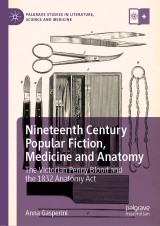Details

Nineteenth Century Popular Fiction, Medicine and Anatomy
The Victorian Penny Blood and the 1832 Anatomy ActPalgrave Studies in Literature, Science and Medicine
|
90,94 € |
|
| Verlag: | Palgrave Macmillan |
| Format: | |
| Veröffentl.: | 18.01.2019 |
| ISBN/EAN: | 9783030109165 |
| Sprache: | englisch |
Dieses eBook enthält ein Wasserzeichen.
Beschreibungen
<p>This book investigates the relationship between the fascinating and misunderstood penny blood, early Victorian popular fiction for the working class, and Victorian anatomy. In 1832, the controversial Anatomy Act sanctioned the use of the body of the pauper for teaching dissection to medical students, deeply affecting the Victorian poor. The ensuing decade, such famous penny bloods as <i>Manuscripts from the Diary of a Physician, Varney the Vampyre</i>, <i>Sweeney Todd</i>, and <i>The Mysteries of London</i> addressed issues of medical ethics, social power, and bodily agency. Challenging traditional views of penny bloods as a lowlier, un-readable genre, this book rereads these four narratives in the light of the 1832 Anatomy Act, putting them in dialogue with different popular artistic forms and literary genres, as well as with the spaces of death and dissection in Victorian London, exploring their role as channels for circulating discourses about anatomy and ethics among the Victorian poor.</p>
1. Preface: Dissecting a Literary Monster.- 2. Penny Bloods, The Anatomy Act, and a Common Ground for Analysis.- 3. <i>Manuscripts from the Diary of a Physician</i>: Power, Ethics, and the Super-Doctor.- 4. Coping with the Displaced Corpse: Medicine, Truth, and Masculinity in <i>Varney the Vampyre</i>.- 5. Underground Truths: <i>Sweeney Todd</i>, Cannibalism, and Discourse Control.- 6. The Unknown Labyrinth: Radicalism, The Body, and the Anatomy Act in <i>The Mysteries of London</i>.- 7. Dissection Report: Patterns of Medicine and Ethics.
<div><p>Anna Gasperini received her PhD from the National University of Ireland Galway. She specialises in Victorian popular fiction, Victorian medical history, and spatial and discourse theory. She is the current Membership Secretary of the UK-based Victorian Popular Fiction Association (VPFA).</p><br></div>
‘The 1832 Anatomy Act was a crime against the poor. Anna Gasperini uses to it explain why corpses, monsters, demon barbers and body snatchers populated cheap fiction in the early Victorian years. This is a major inter-disciplinary study that establishes the gothic penny dreadful as a vital source for understanding popular culture in the age of Dickens and the Chartists.’ — Rohan McWilliam, Professor of Modern British History, Anglia Ruskin University, UK<div><br></div><div>'Anna Gasperini’s <i>Nineteenth-Century Popular Fiction, Medicine, and Anatomy </i>is a welcome addition to scholarship on early Victorian narrative, the history of medicine, and popular culture. This deftly written, meticulously researched monograph reads like a novel and identifies a subject that we have strangely overlooked: the surge of popularity in the penny blood at a time when medical experimentation was unstandardized or — worse — adjudicated by class.' — Tabitha Sparks, Associate Professor of English, McGill University, Canada</div><div><p>‘Dr Gasperini brilliantly resurrects from unjust neglect the penny bloods and penny dreadfuls so beloved of poor and working-class late-Georgians and Victorians. She skilfully traces the impact of the bodysnatching / burking furore and subsequent Anatomy Act on the genre. She expertly reveals the eerie and uncanny spaces of 19<sup>th</sup>-century London as providing a dominant inspiration for these proto-horror tales, and explores how the inexorable rise of the medical profession contributed a deep sense of unease for a metropolitan population who feared that their material being was vulnerable to being co-opted for the progression of science. This is a long-overdue and highly intelligent examination of the literature of the socially powerless and underprivileged - and a terrific read, to boot.’ — Sarah Wise, Lecturer and author, City University London, UK</p><p>This book investigates the relationship between the fascinating and misunderstood penny blood, early Victorian popular fiction for the working class, and Victorian anatomy. In 1832, the controversial Anatomy Act sanctioned the use of the body of the pauper for teaching dissection to medical students, deeply affecting the Victorian poor. The ensuing decade, such famous penny bloods as <i>Manuscripts from the Diary of a Physician, Varney the Vampyre</i>, <i>Sweeney Todd</i>, and <i>The Mysteries of London</i> addressed issues of medical ethics, social power, and bodily agency. Challenging traditional views of penny bloods as a lowlier, un-readable genre, this book rereads these four narratives in the light of the 1832 Anatomy Act, putting them in dialogue with different popular artistic forms and literary genres, as well as with the spaces of death and dissection in Victorian London, exploring their role as channels for circulating discourses about anatomy and ethics among the Victorian poor.<br></p></div>
Analyses four narratives within the context of the 1832 Anatomy Act and its aftermath Explores penny bloods’ elaboration of discourses about anatomy-related anxieties, such as cannibalism, medical voyeurism, and resurrectionism Develops an interconnected discussion about the inclusion in the fictional narratives of real spaces and events relating to the Anatomy Act's history
Diese Produkte könnten Sie auch interessieren:

The Enigma of Good and Evil: The Moral Sentiment in Literature

von: Anna-Teresa Tymieniecka

309,23 €















